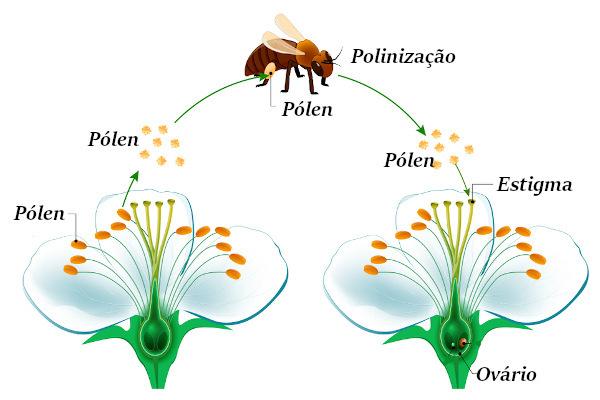At bees are extremely important animals for the environment, as they are responsible for the pollination of several species of angiosperms. They are part of the group of arthropods, more precisely of the class of insects and of the order Hymenoptera. Some species live in society and present work organization. In a hive, we observe the presence of the queen, the drone and the workers.
It is noteworthy that in the world there are several species of bees, with a total of more than being currently known. 20 thousand species. In this text, we will talk a little more about beesApis mellifera, the best known, studied and also bred species in the world.
Read too: October 3rd - Bee Day
General characteristics of bees
Bees are animals of the Arthropoda phylum, so they inherit some typical characteristics of this group, such as the fact that they have a exoskeleton that involves your body. They are part of the Insecta class, presenting, therefore, body divided into three parts (head, chest and abdomen), three pairs of legs, one pair of antennae and two pairs of wings.
The structures responsible for the senses of this animal are housed in the head, such as the antennae, which are linked to smell and hearing. It is also in the head that we find the eyes, being two compound eyes situated laterally and three ocelli located in the frontal region, arranged in a triangular arrangement. Compound eyes are responsible for forming the images, while ocelli are only capable of detecting light.
The bees' mouthparts, also located in the head, ensure that this animal is able to absorb liquids and also chew. At jaws they help bees to cut and manipulate the wax and propolis they produce, as well as help in ingesting pollen and removing unwanted particles from the hive. The structure that guarantees the absorption of liquid substances, in turn, is called proboscis or tongue.

At legs and wings, which are the locomotor organs of bees, are in the thorax. The legs are found in the number of six (three pairs), each pair in a segment, being responsible, in addition to locomotion, by transporting pollen, handling wax and propolis, in addition to cleaning the body of the Bee. The wings are found in the number of 4 (two pairs) and guarantee the animal's flight. The front wings are larger than the hind wings. The thorax of bees is rich in hair, which helps in fixing pollen.
In the abdomen of bees, most of the organs are found, such as the honey bird, which guarantees the transformation of nectar into honey; glandscerigens, which produce the wax; stomach and intestine. In the final portion of the abdomen, the sting, which, in the worker, assumes the role of defense and, in the queen, the role of guide in posture. The drone does not own it. It is worth noting that the stinger is connected to the venom pouch, which releases a complex mixture of different substances called apitoxin.
Read too: Importance and chemical composition of honey
bee communication
Bees are animals that live in society and are able to communicate with each other. There are different ways for a bee to communicate with another, being the dances and the release of pheromones (chemicals produced by the animal) some of these forms. Dances are used, for example, to indicate the direction and distance of food. With regard to pheromones, we can mention the alarm pheromone, produced by workers, which alerts other workers about the approach of an enemy, and the mandibular gland pheromone, produced by the queen, which attracts drones to the reproduction.
bee society

When we observe a hive, we see that the individuals who live in it work cooperatively and there is a division into castes. The three castes are queen, drone and worker.
- Queen: the only female that breeds in that society, and each hive has only one queen. The queen's fertilization takes place during the nuptial flight, a time when several drones can fertilize her. About five days after fertilization, the queen lays the eggs in the so-called combs, more precisely in the alveoli, which are manufactured by the workers. In addition to ensuring reproduction, the queen has the role of keeping all bees inside the hive, which is achieved thanks to the release of an aggregation pheromone.
- Workers: they are also female bees, but they are not capable of reproducing. They carry out different activities inside the hive, such as cleaning the place, feeding the queen and individuals in the larval stage, producing wax, collecting nectar and pollen, among other functions. It is noteworthy that, in the absence of a queen, some workers can lay eggs, but these are not fertilized, giving rise, therefore, only to drones.
- Drone: the hive males. Its function in bee society is to ensure the queen's fertilization. After performing fertilization, drones die, due to the loss of sexual organs during copulation.
It is important to point out that each variety has some peculiarities with regard to its anatomy and morphology. The queen, for example, is longer than the other castes, and the drone has a thicker appearance. The workers, in turn, are the smallest of the group.
bee life cycle
Bees are animals that pass through metamorphosis, being possible to distinguish four stages of development in this animal: egg, larva, pupa and adult. The queens are responsible for laying eggs, this being the first stage of the bee's development. The eggs stay in the alveoli of the combs. Those that give rise to drones are deposited in larger alveoli than those that receive the eggs that give rise to workers. It is noteworthy that bees are able to control the fertilization process. Unfertilized eggs produce drones, and fertilized eggs produce females.
After the egg stage, there is the birth of a larva, which resembles a small caterpillar, with a white color. This larva is positioned at the bottom of the alveolus, feeds and grows. After five molts, the end of the larval stage is reached. Its alveolus is covered with wax and the larva weaves a thin cocoon. The pupa stage begins, in which the bee undergoes a complete metamorphosis. After the metamorphosis, the bee breaks the alveolus lid and begins the adult phase.
Read too:Molting or ecdysis in arthropods
Importance of bees

Bees have great ecological importance, being essential for the reproduction of a wide variety of angiosperms. these insects are animals pollinators, that is, they ensure the transport of pollen from one plant to another and, in this way, promote the plant's reproduction. Bees are also animals of great economic importance, being bred for the purpose of producing various products, such as honey, propolis and royal jelly.
By Vanessa Sardinha dos Santos
Biology teacher



